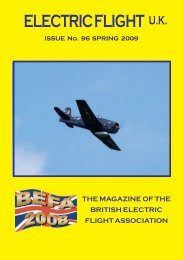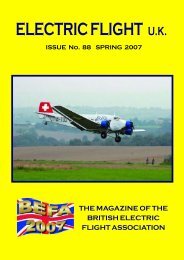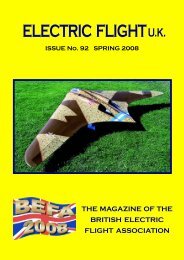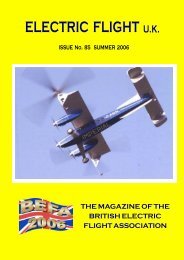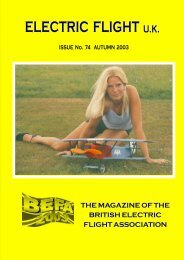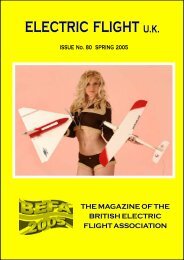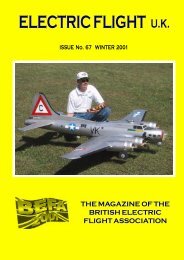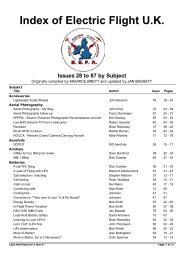electric flight uk - British Electric Flight Association - Jan Bassett's
electric flight uk - British Electric Flight Association - Jan Bassett's
electric flight uk - British Electric Flight Association - Jan Bassett's
You also want an ePaper? Increase the reach of your titles
YUMPU automatically turns print PDFs into web optimized ePapers that Google loves.
A Smarter Dart<br />
by John Stennard<br />
I’m going to begin with some background information before launching the Smarter<br />
Dart. I am a committed <strong>electric</strong> flier with a particular interest in indoor flying<br />
and as a result also organise the indoor flying sessions for our club. As part of my<br />
indoor interest I write monthly features for two model magazines and this combined<br />
with my club involvement, has resulted in a constant search for a model that can<br />
be flown as an indoor trainer but also be enjoyed by flyers with more experience.<br />
I regularly fly in different sized venues that vary from a one basketball court gym<br />
to a five badminton court sports hall. At last believe I have found a model that can<br />
be flown comfortably in the smallest to the largest hall and put a smile on any<br />
flier’s face. Before going into details I think it is worth spending a short time<br />
looking at the requirements of an ‘indoor’ trainer.<br />
Firstly it needs to be easy to fly and relatively impact proof. Outdoors the ‘impact<br />
proof’ requirement does not rate the same importance as indoors where floor/wall/<br />
ceiling impacts (plus the occasional mid-air!) are a constant hazard. A light wing<br />
loading is essential to enable the model to be flown slowly plus enough power to get<br />
out of trouble. A suitable model combined with a good power system should benefit<br />
from a high power/weight ratio. A ratio of 2:1 is easy to achieve using the correct<br />
motor/battery combination and will provide a high degree of agility.<br />
Agility is extremely important when flying in smaller spaces and can frequently<br />
save models from collision damage. A reasonable duration is need never a problem<br />
and anywhere between 5-10 minutes is easily obtained and perfectly adequate. In<br />
fact in crowded venues you might be unpopular if you stayed aloft for much longer.<br />
Most <strong>electric</strong> enthusiasts now accept that while many models perform perfectly<br />
well, or are even particularly suited to brushed motors and NiCd/NiMH cells,<br />
indoor models are at their best when combined with brushless motors and Lithium<br />
cells. The model I am writing about in this feature is powered by a low cost,<br />
brushless motor and flies extremely well using a 2s1p LiPo pack. The GWS IPS<br />
system is suggested as an alternative but I’m personally only interested in fitting<br />
the optimum power system.<br />
Now let’s take a look at the model. Paul Cook produces a number of excellent<br />
plans for <strong>electric</strong> enthusiasts. These are all small high performance <strong>electric</strong> powered<br />
models, and the plans are extremely well drawn and printed. Paul’s plans are<br />
available direct from him at <strong>flight</strong>line@hotmail.co.<strong>uk</strong><br />
One of Paul’s plans is for an enlarged RC version of the rubber powered BMFA<br />
Smart Dart and is called the Smart Dart ‘XS’. His model has a 560mm (22”)<br />
wingspan and weighs around 125g (4.4oz.). Paul’s first version of this model has<br />
a 3mm (1/8”) balsa fuselage and built up wings, tailplane and fin using different<br />
widths of 3mm strip balsa. The flying surfaces are covered in lightweight film<br />
E.F.-U.K. 61



